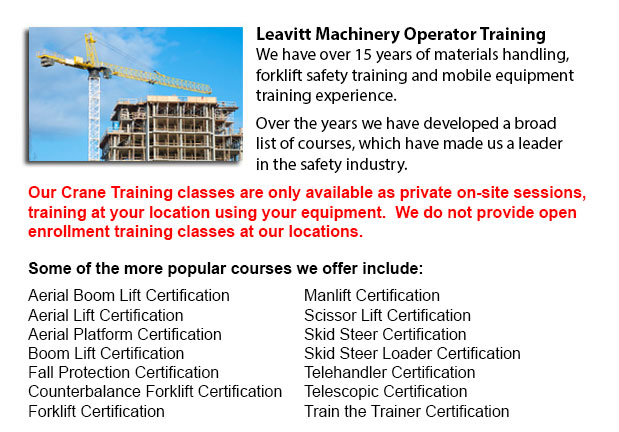
Crane Certification Saskatchewan - The Crane Certification Program includes the industry recommended content that will teach the safe and efficient operation of cranes. The individual will train in the following: pre-operational, operational and post operating requirements; how to identify cranes and their component parts; how to determine overall lift capacity; rigging components and inspection/rejection criteria; and requirements particular to the work location where the people training would be operating.
Pre-operational requirements consist of assigning authority for the pre-operational check; performing the sequential pre-operational check based on the manufacturer's specifications or specifications certified by a professional engineer; checking the work place for obstacles and hazards; checking the log book for comments; inspecting chains, cables, hooks safety latches and crane movement; ensuring the correct functioning of operational controls; and knowing how to make sure that the crane's disconnect switch/isolator is working properly.
Operational requirements include identifying roles and responsibilities, and determining the requirement for a formal lift plan. Individuals training will be taught how to carry out a danger assessment connected to environmental situations, physical situations and staff. Subject matter includes determining when to seek competent help, the safest route and destination of loads, and load weight and centre of gravity.
Trainees should be able to identify an over-capacity lift, in addition to be able to choose right rigging equipment, choose load limitations, and to determine the safe site for the crane to work from. People training will review both universal and site-specific crane signals for lifts, and methods for traveling, lifting and loading. Appropriate maintenance habits will also be included.
The individuals training will undergo an examination to test their understanding of emergency response techniques for various scenarios, particularly mechanical or electrical failures. They will be asked to describe parking and shut down procedures for security and safety, to follow tagging and lock out procedures, and to explain the reason why near misses are recorded and reported to the right person. Log book records should be maintained.
The person training will know the particulars of rigging, and learn the responsibility and authority for rigging. They will know to identify the different types of rigging, storage procedures and the load capacity ratings.
The requirements following operation of the crane would be taught also, learning to enter the defects and deficiencies; and to log the history of service and maintenance records, in accordance to the provincial, federal and state codes requirements.
What's more, we include site-specific needs to meet the employers needs into our crane certification training program.
-
Forklift Ticket Saskatchewan
Forklift Ticket Saskatchewan - Pallet jacks and forklifts are both meant for basically the same purpose; to move supplies from one location of your warehouse to another. This is pretty much where the comparison stops however. With the pallet jack, th... More -
Loader Ticket Saskatchewan
Loader Ticket Saskatchewan - Gehl articulated loaders have been made to suit practically any condition. They provide great traction and optimal maneuverability due to a heavy-duty oscillating joint that offers forty five degree rotating angles left a... More -
Forklift Training Programs Saskatchewan
Forklift Training Programs Saskatchewan - Are you searching for work as a forklift driver? Our regulatory-compliant mobile equipment operator training provides instruction in kinds of forklifts, pre-shift check, fuel kinds and handling of fuels, and... More -
Heavy Equipment Operator Classes Saskatchewan
Heavy Equipment Operator Classes Saskatchewan - A heavy equipment operator is an individual who has received the right training in order to operate a particular kind or piece of machinery. There are lots of ways for the operator to undergo training a... More -
Telehandler Training in Saskatchewan
Telescopic handlers usually known as telehandlers for short, are an extremely popular piece of heavy construction equipment. They are usually utilized in the construction and agricultural trades. These equipments have farthest reaching capacity and a... More -
Narrow Aisle Forklift / Order Picker Training / Electric Pallet Jack / Electric Pallet Truck Training in Saskatchewan
A pallet lift is a piece of equipment dedicated in the transporting of pallets of various dimensions and weights. They can be utilized as an attachment for forklifts, cranes and other types of heavy machinery or be applied on their own. Pallet lifts... More -
Operator Safety Training, Re-Qualification Training, In-House Instructor Training in Saskatchewan
Used in just about all industrial construction sites, warehouse operations or boat yards, the lift truck is a very important component so as to help pick up and transfer supplies. The reach feature of a forklift can help improve the applications whic... More -
Aerial Lift Ticket Saskatchewan
Aerial Lift Ticket Saskatchewan - Boom vehicle are often used by phone, cable and utilities firms as they have extended folded arms which are generally folded over the roofs of business vehicles. On the end of the extension of extendable arms usually... More

Forklift Training Saskatchewan
TOLL FREE: 1-888-254-6157
Saskatoon, Saskatchewan
forklifttrainingsaskatchewan.com
Email Us
About Us



